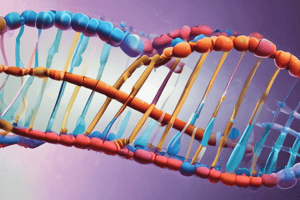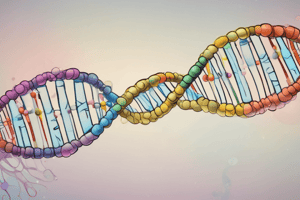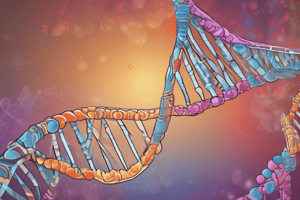Podcast
Questions and Answers
What are the two types of nitrogen-containing bases found in DNA?
What are the two types of nitrogen-containing bases found in DNA?
- Purines and Pyrimidines (correct)
- Purines and Pyrazines
- Amino acids and Peptides
- Ketones and Aldehydes
What is the main function of the phosphate group in a nucleotide?
What is the main function of the phosphate group in a nucleotide?
- To bind with the nitrogen-containing bases
- To provide energy for DNA replication
- To stabilize the double helix structure
- To form the backbone of the DNA molecule (correct)
What is the direction of the nucleotide strands in a DNA molecule?
What is the direction of the nucleotide strands in a DNA molecule?
- Parallel and complementary
- Antiparallel and identical
- Parallel and identical
- Antiparallel and complementary (correct)
What is the direction of strand elongation during DNA replication?
What is the direction of strand elongation during DNA replication?
What type of bonds hold the nucleotide strands together in a DNA molecule?
What type of bonds hold the nucleotide strands together in a DNA molecule?
What is the name of the model that describes the structure of DNA as a double helix?
What is the name of the model that describes the structure of DNA as a double helix?
Which of the following is NOT a basic requirement for DNA replication?
Which of the following is NOT a basic requirement for DNA replication?
What is the function of primase during DNA replication?
What is the function of primase during DNA replication?
What is the term for the process of replication where the new DNA molecules contain one old strand and one new strand?
What is the term for the process of replication where the new DNA molecules contain one old strand and one new strand?
Which of the following statements is TRUE regarding DNA replication?
Which of the following statements is TRUE regarding DNA replication?
What does the term "semi-conservative replication" refer to in the context of DNA replication?
What does the term "semi-conservative replication" refer to in the context of DNA replication?
What is the role of the "old" DNA strand in DNA replication?
What is the role of the "old" DNA strand in DNA replication?
Why is the direction of DNA synthesis always 5' to 3'?
Why is the direction of DNA synthesis always 5' to 3'?
What is the significance of the fact that DNA is synthesized in a 5' to 3' direction?
What is the significance of the fact that DNA is synthesized in a 5' to 3' direction?
What is the initial step in the DNA replication process?
What is the initial step in the DNA replication process?
Which enzyme is primarily responsible for synthesizing new DNA strands during replication?
Which enzyme is primarily responsible for synthesizing new DNA strands during replication?
Which of the following correctly describes the elongation phase of DNA replication?
Which of the following correctly describes the elongation phase of DNA replication?
What occurs during the termination phase of DNA replication?
What occurs during the termination phase of DNA replication?
Which statement about the origin of replication is accurate?
Which statement about the origin of replication is accurate?
Flashcards are hidden until you start studying
Study Notes
DNA Overview
- Deoxyribonucleic Acid (DNA) is a nucleic acid located in the nucleus.
- DNA is a polymer composed of nucleotides, each containing:
- A deoxyribose sugar (5-carbon sugar)
- A phosphate group
- A nitrogenous base
Nitrogenous Bases
- Four nitrogenous bases in DNA:
- Purines: Adenine (A), Guanine (G)
- Pyrimidines: Thymine (T), Cytosine (C)
Structure of DNA
- DNA is structured as a double helix, with two nucleotide strands.
- Strands run in antiparallel directions, meaning they orient differently.
- Hydrogen bonds form between bases: A pairs with T, C pairs with G.
- The "ladder" structure consists of a sugar-phosphate backbone and base pairs as rungs.
- During replication, the parent strand acts as a template for producing daughter DNA strands.
DNA Replication Process
- Replication is semi-conservative; each new DNA molecule contains one old strand and one new strand.
- Replication occurs in the 5' to 3' direction.
- Energy for synthesis derives from the removal of two phosphates from incoming nucleotides.
- Replication features:
- Initiation occurs at specific origins.
- Bidirectional movement is typical during synthesis.
- Strands elongate in a 5' to 3' direction and are semi-discontinuous.
Requirements for DNA Replication
- Requires several key components:
- Templates from both strands of parental DNA.
- Nucleotides: dATP, dTTP, dGTP, dCTP.
- Enzymes: DNA polymerase, helicase, primase, ligase.
- RNA primer for initiating synthesis.
- Single-strand binding proteins (SSB) for stabilization.
- Proofreading occurs as an error control measure during replication.
Leading and Lagging Strands
- The leading strand is synthesized continuously in the same direction as the replication fork.
- The lagging strand is synthesized discontinuously, moving away from the replication fork, forming short segments known as Okazaki fragments.
Steps of DNA Replication
- DNA replication in prokaryotes begins at a single origin and travels bidirectionally around the circular DNA molecule.
- Three primary steps in replication:
- Initiation: The process begins at the origin of replication.
- Elongation: DNA polymerase synthesizes new DNA strands.
- Termination: The replication process concludes once the entire molecule is copied.
Studying That Suits You
Use AI to generate personalized quizzes and flashcards to suit your learning preferences.




